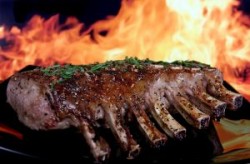In many areas of life, the best things often come in small packages. Grilling is no exception. One of the most important grilling tools you will ever own is likely one of the smallest. That tool is the BBQ thermometer.
BBQ Thermometer Basics
A quality thermometer allows you to accurately monitor the internal temperature of your meat. Whether you are looking for a perfectly crusted rare steak, a tender pork tenderloin, or fall-off-the-bone pulled pork barbecue, the BBQ thermometer helps you achieve consistent results every time.
Many hold the chef in high esteem who has a “6th sense” about the doneness of his meat. Some outdoor chefs are able, with the prod of a finger, to determine with astonishing accuracy how done their meat is. This skill is developed with many years of experience and is rarely mastered by any but the most proficient chefs. For the rest of us, there is the BBQ thermometer. It’s the tool that lets you grill like a master every time.

BBQ Thermometer Types
A variety of BBQ thermometers are available for use, and some are more effective than others. The two main types of meat thermometers are known as instant-read thermometers and leave-in thermometers. For the sake of this article we will limit our discussion to digital thermometers because of their accuracy and rare need for calibration.
Instant-read BBQ thermometers are designed to be inserted into the meat during the cooking process. Upon insertion, the BBQ thermometer reads the meat temperature, displays it for the chef, and is removed from the meat. A good instant-read thermometer is able to accurately read the temperature of the meat within 1 to 3 seconds of being inserted. Unfortunately, the vast majority of instant-read thermometers fall far short of this benchmark. The lower quality instant-read thermometers either sacrifice accuracy for a rapid
temperature reading, or vice versa. Few attain both accuracy and speed, and the ones that do are relatively expensive. The Thermapen, made by Thermoworks, is one high quality instant-read BBQ thermometer that has gained a reputation for accuracy and speed. It is recommended by many chefs worldwide and has become the industry standard for such thermometers.
Leave-in BBQ thermometers are designed to be inserted into the meat before cooking and left there until the cooking is done.
These thermometers are typically more affordable because they only have to achieve one thing: accuracy. Some home chefs are concerned that the wire connecting the probe to the thermometer will melt in the grill or oven. This is typically not a problem because the wire is coated with a plastic coating that can withstand high temperatures. Many companies offer good leave-in thermometers, but Polder has gained a name for quality in the grilling community. They offer a variety of leave-in thermometers, some with more than one probe, and some with wireless alert systems that can even send a message to your smartphone when your meat is done.
BBQ Thermometer Use
Both thermometer types have their strengths and weaknesses. The instant-read thermometer is perhaps the more versatile of the two, but its cost can be prohibitively high for the average home chef. The leave-in thermometer works well for larger cuts of meat such as pork shoulder or loin, but can mar the visual appeal of more delicate meats like salmon or chicken. For steaks that are 12 ounces or more, either thermometer type works well. Less than 12 ounces and the steak can get too thin for the leave-in thermometer.
Whether you opt for the more costly instant-read or slow and steady leave-in bbq thermometer, use it to achieve the perfect medium-rare steak that will astound your friends and family.
Go back to BBQ Accessories Main Page
Go to iGrillBBQ.com Home Page from BBQ Thermometer